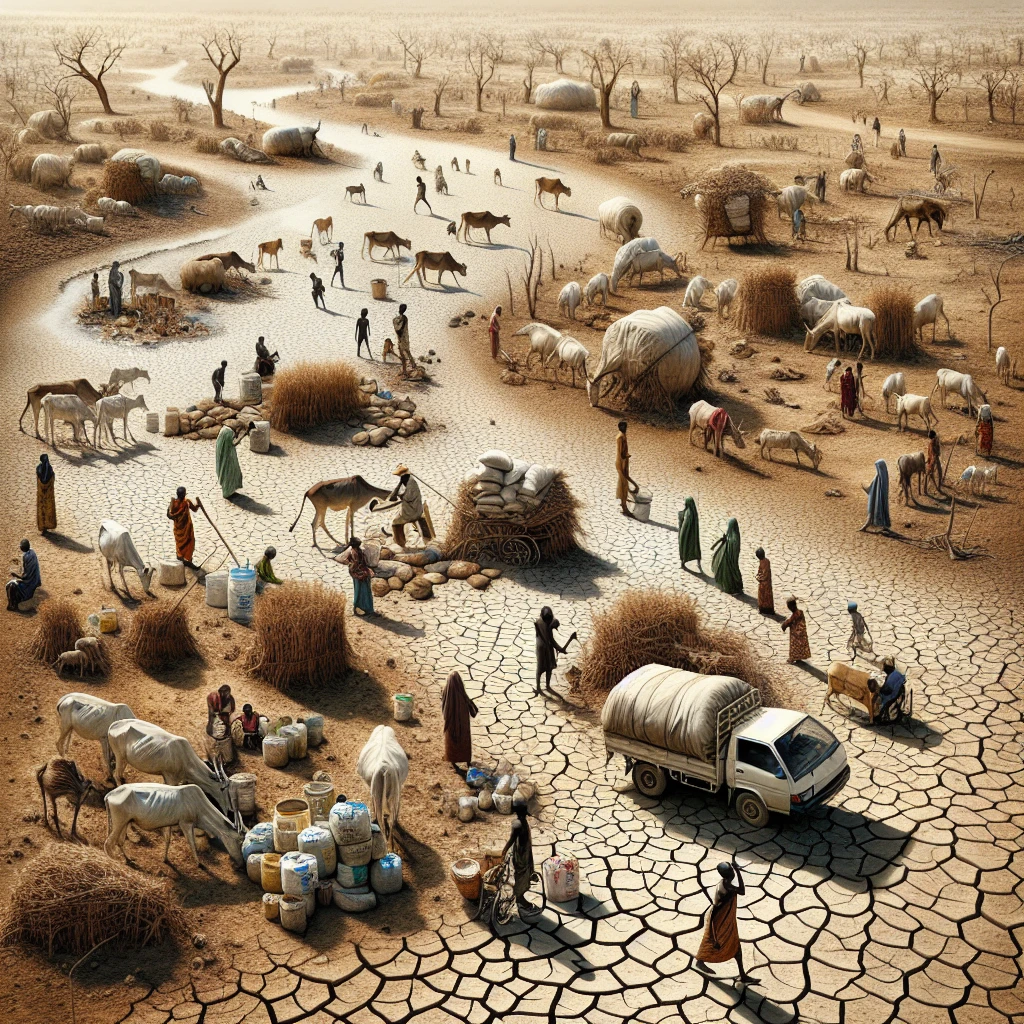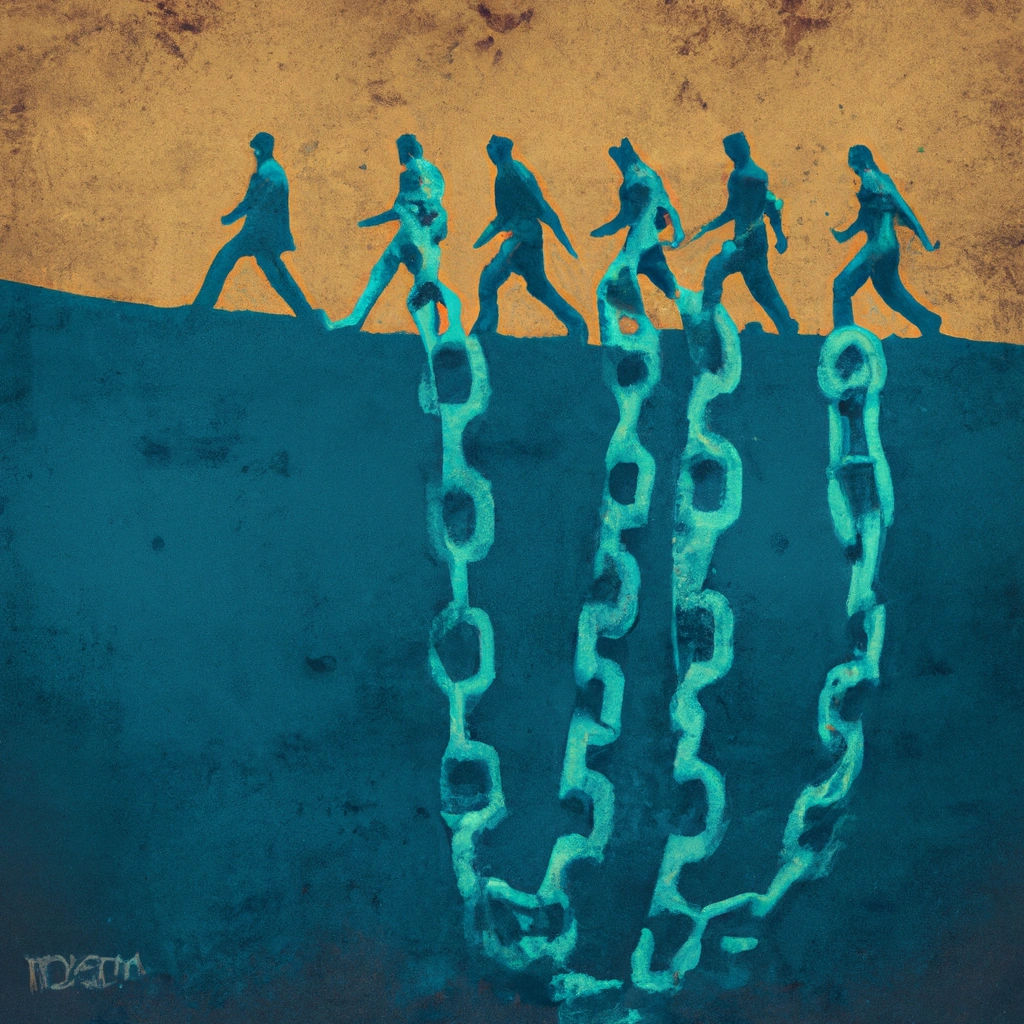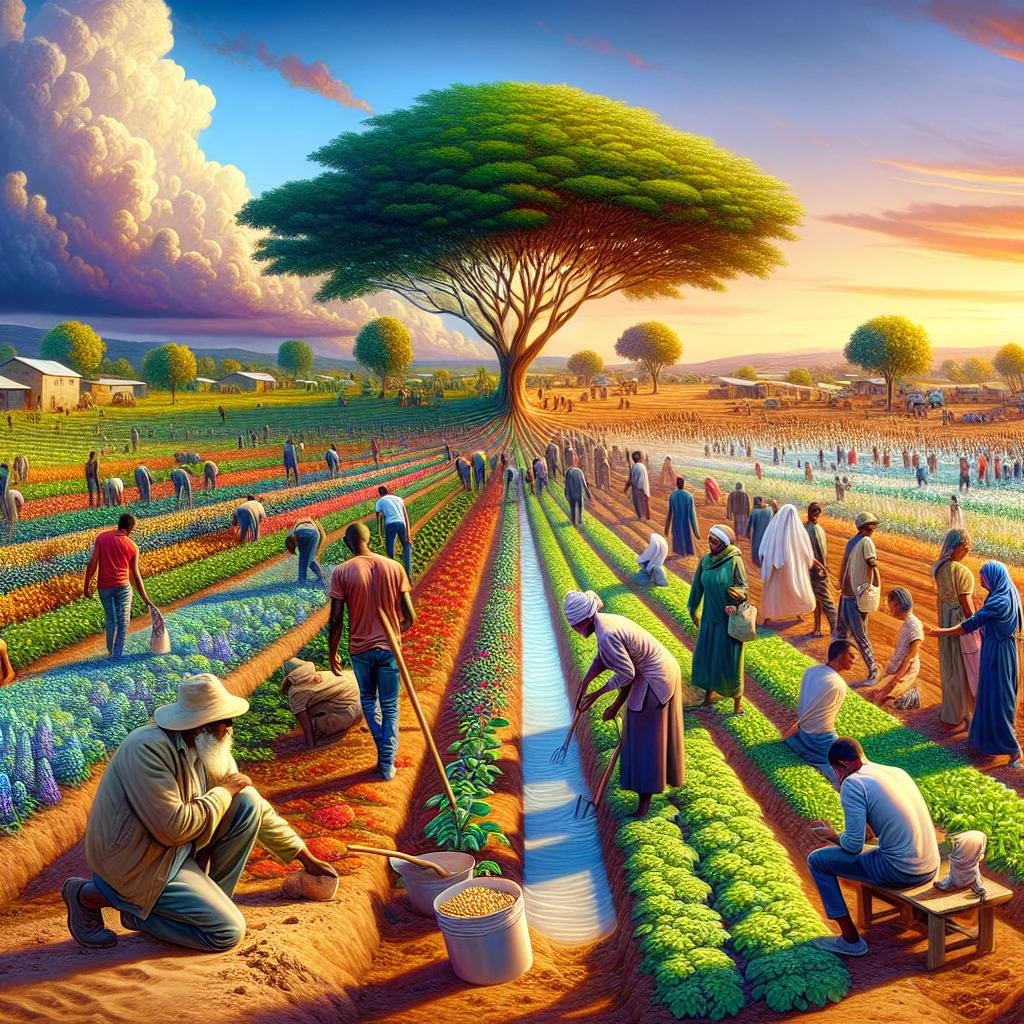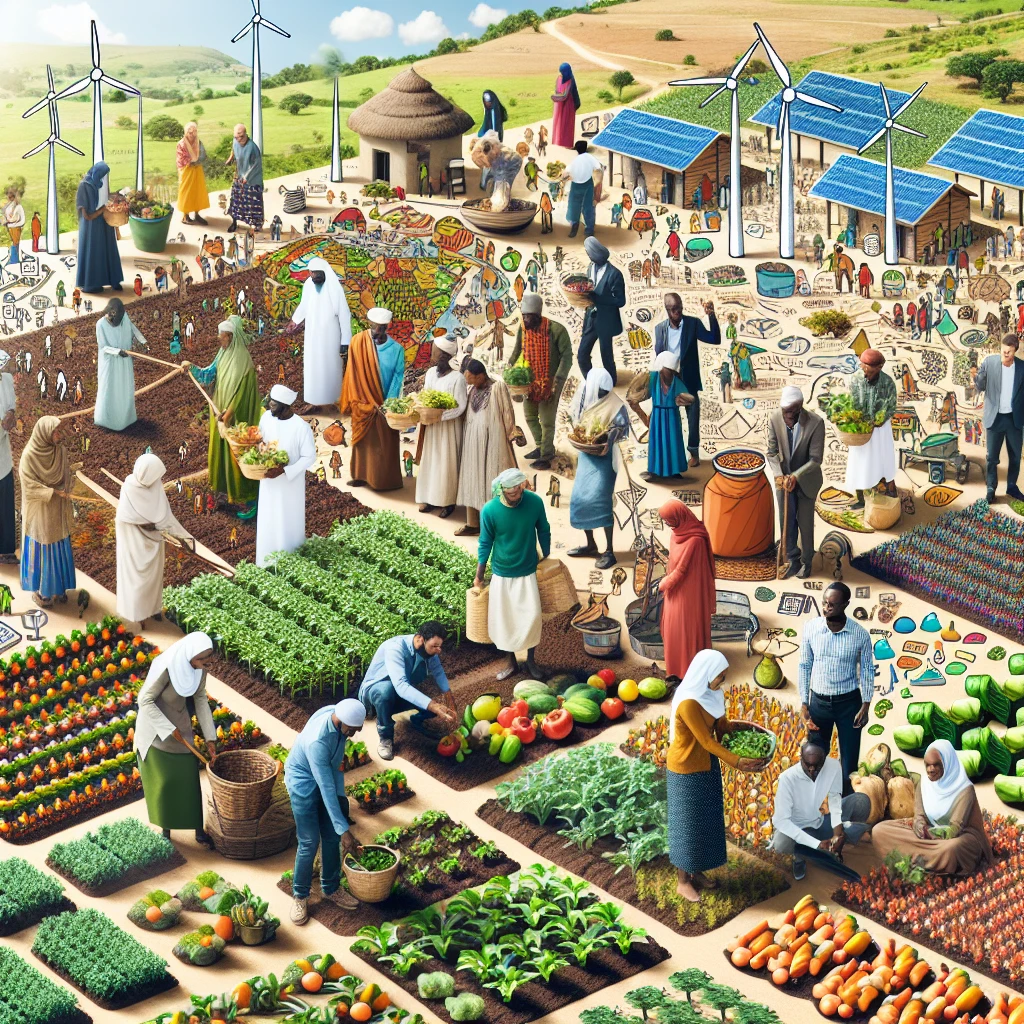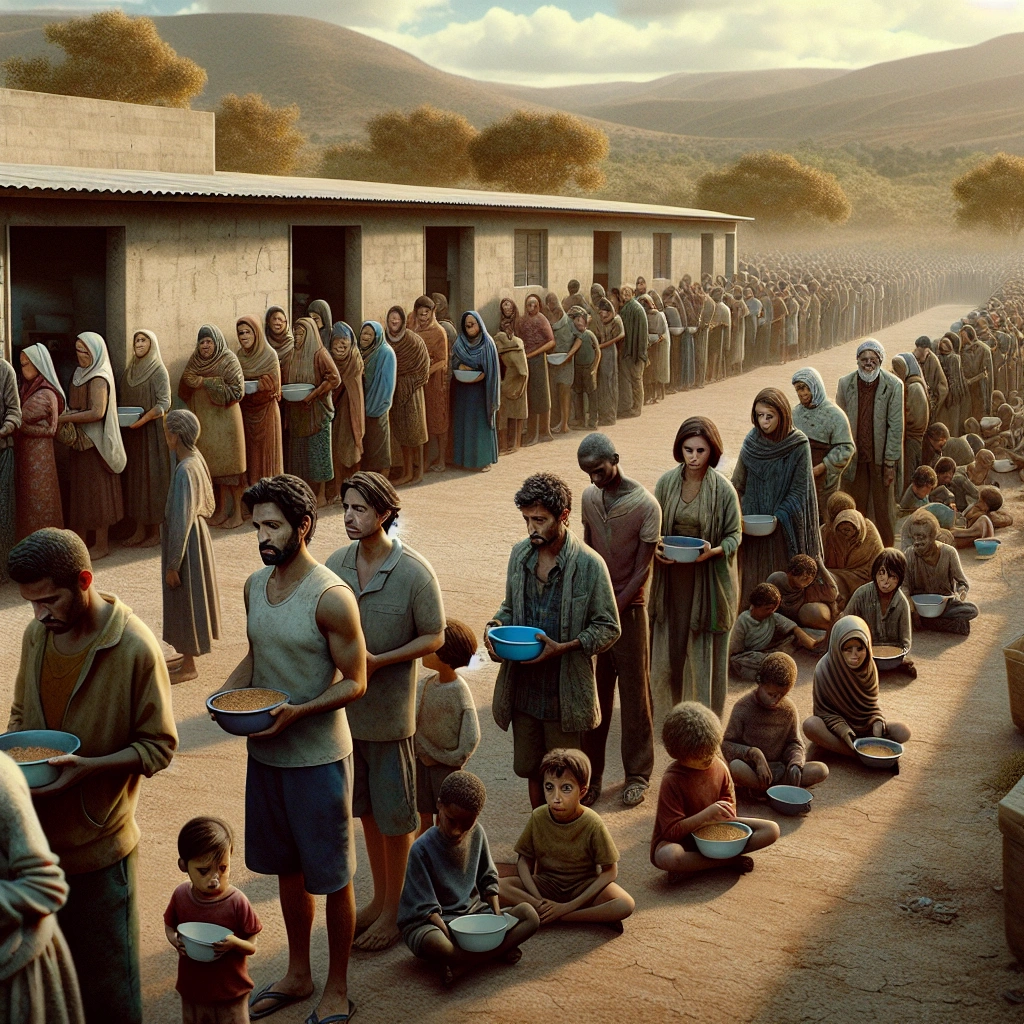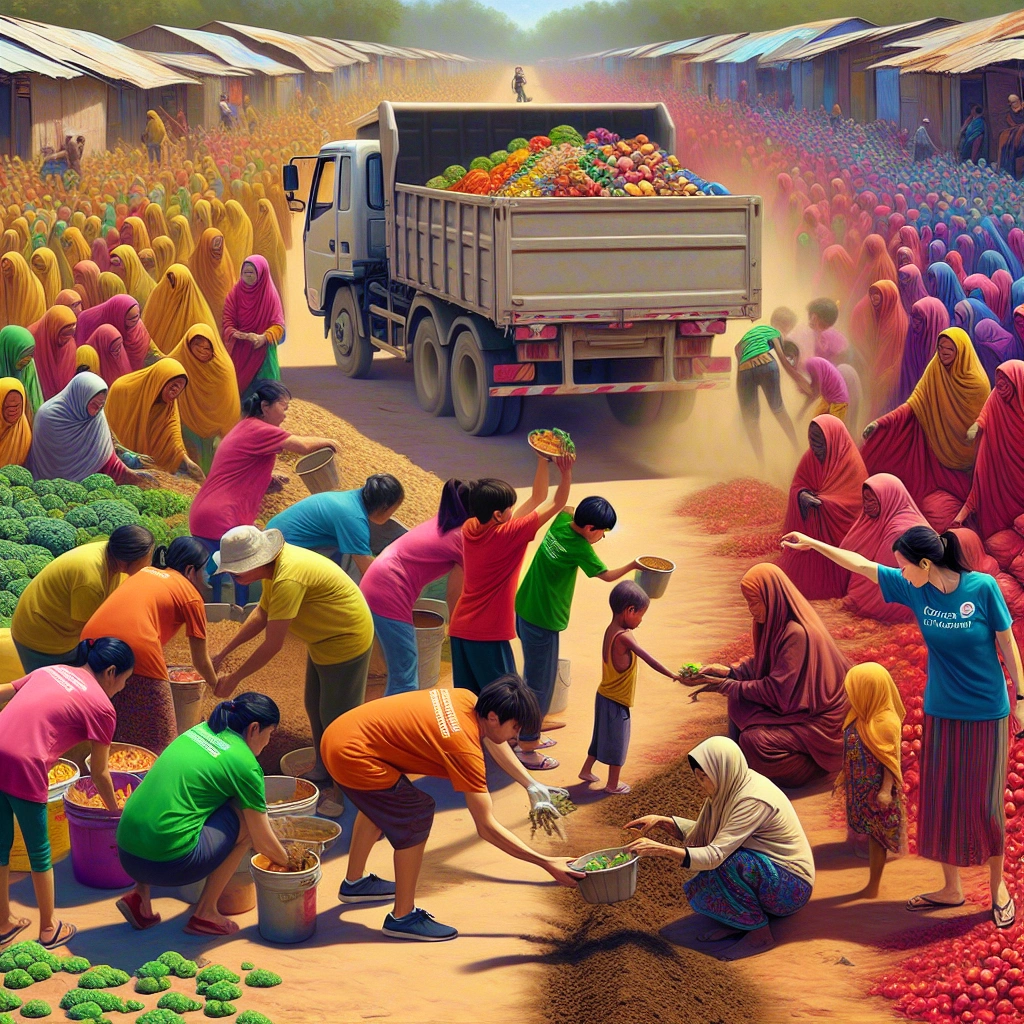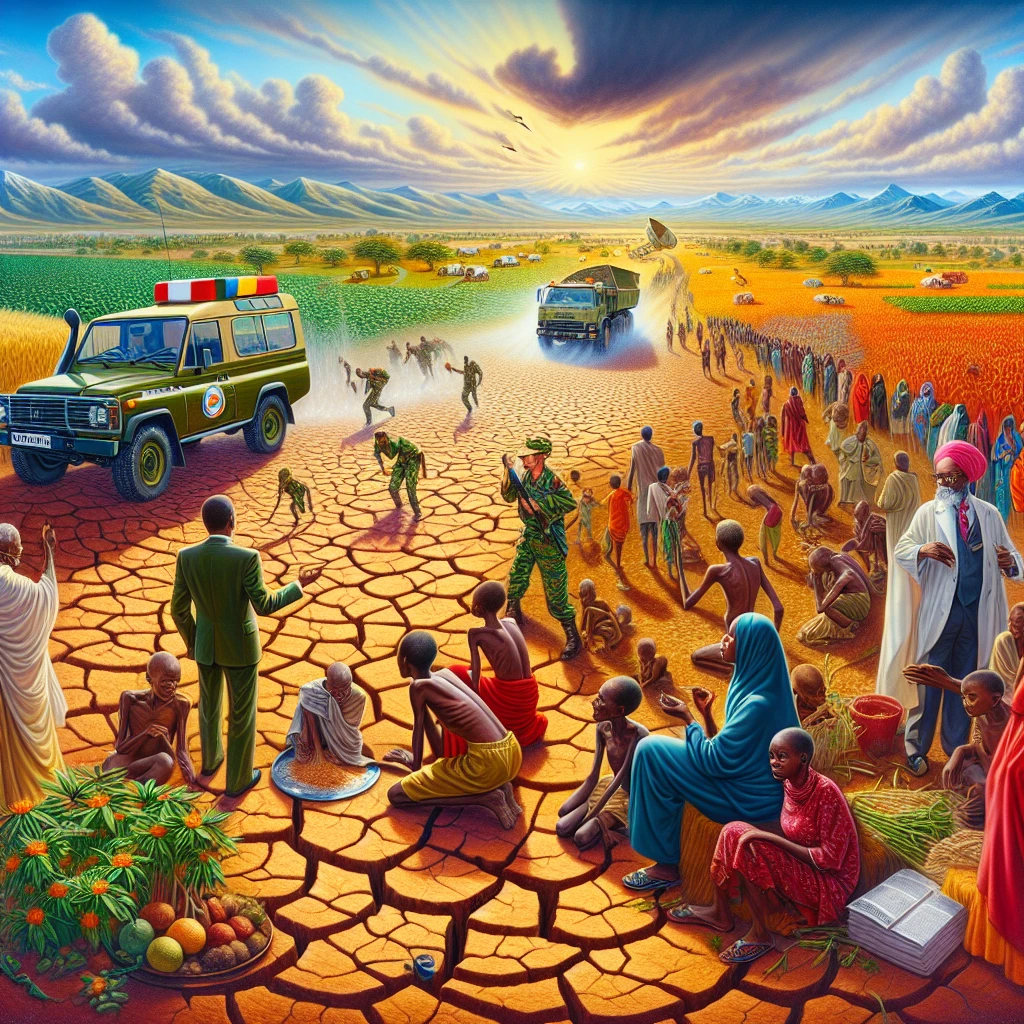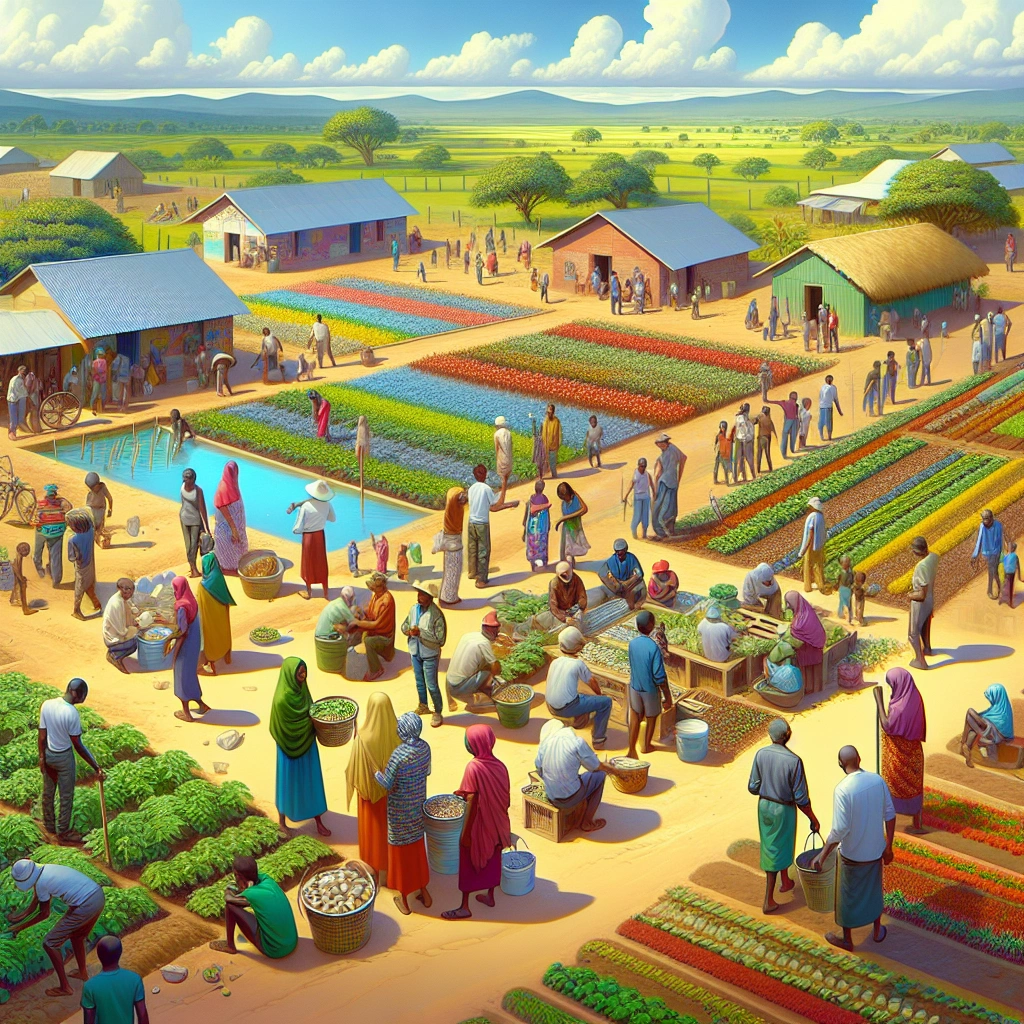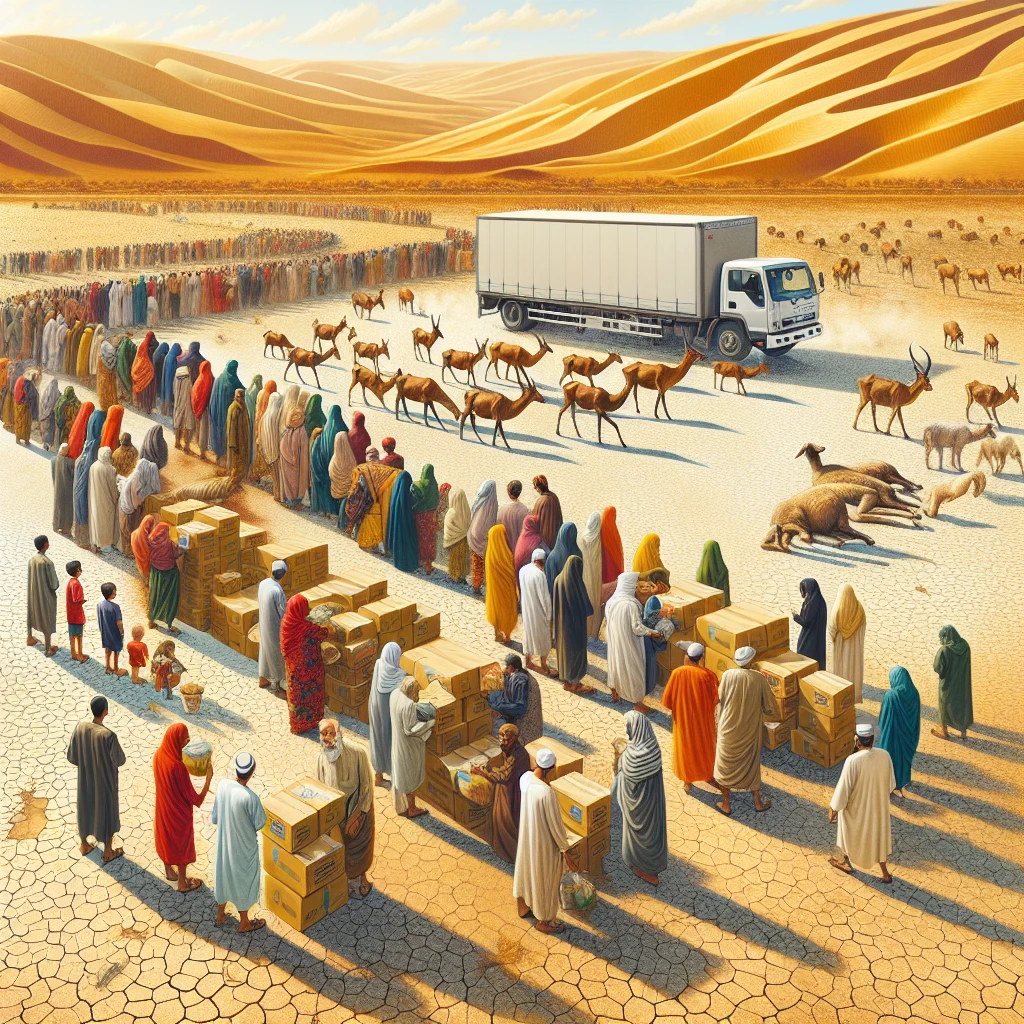

The Horn of Africa is currently facing a severe food shortage crisis, with nearly 60 million people in IPC3+ experiencing acute food insecurity.
Understanding the statistics of food shortage in the region is important, as it helps to highlight the magnitude of the crisis and the urgent need for intervention and assistance.
Factors such as drought, conflict, displacement, and rising food prices have contributed to the worsening food shortage situation in the Horn of Africa.
The Impact of Food Shortage in the Horn of Africa
Effects on Human Health and Well-being
The food shortage in the Horn of Africa has had a catastrophic impact on human health and well-being. More than 500,000 children under the age of five are severely malnourished, with an estimated 1.1 million people already displaced by the current crisis.
Moreover, a preliminary study found that 76% of Somalis have experienced psychological disorders due to the food scarcity. This situation has led to increased vulnerability to diseases and a surge in infectious diseases like cholera, measles, and malaria.
Impacts on the Economy and Livelihoods in the Region
The food shortages in the Horn of Africa are not just affecting human health but also have far-reaching implications on the economy and livelihoods in the region. Relentless drought and high food prices have weakened people’s ability to grow crops, raise livestock, and purchase food for their families.
Moreover, the acute malnutrition has led to increased migration as populations move in search of food and pasture, resulting in disruptions and deterioration in hygiene and sanitation. This has created a ripple effect on the economic activities in the region, leading to further hardship and instability.
| Aspect | Impact |
|---|---|
| Human Health and Well-being | – More than 500,000 severely malnourished children – 76% Somalis with psychological disorders due to scarcity |
| Economy and Livelihoods in the Region | – Weakened agricultural productivity – Increased migration and instability |
The food shortage statistics in the Horn of Africa paint a grim picture, with severe repercussions on both individuals and the economy in the region.
Factors Contributing to Food Shortage in the Horn of Africa
Drought and climate change
The Horn of Africa is experiencing the longest and most severe drought in the past 40 years due to climatic events. This devastating pattern of below-average rainfall for six consecutive years has led to a scarcity of water and a significant decline in agricultural productivity.
The situation has been exacerbated by climate change, making the region even more vulnerable to food shortages.
Conflict and political instability
The Horn of Africa is one of the most conflict-affected regions in the world, with armed conflicts, political strife, and displacement contributing to food insecurity. These crises have strained resources, disrupted food supply chains, and exacerbated existing challenges arising from the severe drought.
Economic challenges
Economic shocks, including soaring food prices driven up by global events such as the war in Ukraine, have intensified food insecurity in the region. The combination of economic instability, persistent drought, and ongoing conflicts has created a dire situation where millions of people are facing acute hunger and food insecurity.
| Factor | Impact |
|---|---|
| Drought and climate change | Decreased agricultural productivity, water scarcity |
| Conflict and political instability | Disruption of food supply chains, resource scarcity |
| Economic challenges | Soaring food prices, exacerbated food insecurity |
The convergence of these factors has created a critical situation in the Horn of Africa, necessitating urgent and concerted efforts to address the complex challenges and prevent a deepening food crisis.
Historical Context of Food Shortage in the Horn of Africa
Past famines and food crises in the region
In the past decade, the Horn of Africa has faced catastrophic food shortages due to a mix of severe drought and ongoing conflicts. In 2011, Southern Ethiopia experienced a devastating drought and famine, which was a significant turning point in addressing food insecurity in the region.
This crisis affected over 23 million people across parts of Ethiopia, Kenya, and Somalia, highlighting the severity of the situation. Subsequently, the region has been plagued by worsening drought, increased food prices, conflict, and displacement, pushing millions into famine and severe hunger.
Lessons learned from previous experiences
The 2011 food crisis in Southern Ethiopia taught critical lessons about the importance of early responses, timely and flexible funding, and the necessity of coupling humanitarian response with strategic planning. It emphasized the need for proactive measures to mitigate the impact of food shortages.
The region’s vulnerability to drought, conflict, and political instability underscores the urgency of addressing these challenges comprehensively and with sustainable solutions. The food crises in the Horn of Africa have highlighted the need for long-term strategies to prevent future famines and address the root causes of food insecurity.
| Key Lessons Learned |
|---|
| Early responses are crucial |
| Timely and flexible funding is imperative |
| Humanitarian response must be coupled with strategic planning |
Understanding the Current Food Shortage Statistics
Unfortunately, the greater Horn of Africa is grappling with a severe food shortage crisis. The ongoing drought has led to acute hunger for millions in the region.
Notably, the lack of rain has devastated crops and led to a significant increase in malnourished children and adults. According to reports, over 37 million people in the region are projected to reach the third level of food insecurity classification, indicating a dire situation.
Moreover, the recent rainy season was notably the driest in the last 70 years, exacerbating the challenges faced due to the prolonged drought.
Analysis of the current food shortage statistics in the Horn of Africa
The situation has led to approximately 8.3 million people in Somalia facing IPC Phase 3+ food insecurity, highlighting the severity of the crisis. Moreover, over 500,000 children under the age of five are severely malnourished, emphasizing the devastating impact of the food shortage on vulnerable populations.
The implications of this crisis are dire, requiring urgent and comprehensive intervention to address the immediate food security needs of the affected populations.
Comparison to previous years and trends over time
The current food shortage crisis in the Horn of Africa surpasses previous droughts in severity and duration, making it an unprecedented challenge for the region. The prolonged nature of this crisis demands sustained efforts to mitigate its impact and prevent further escalation of the situation.
It is crucial to analyze and learn from previous responses to similar crises to effectively address the food shortage and prevent future occurrences. This comparison provides valuable insights into the evolving nature of food insecurity in the region and the need for adaptive and sustainable solutions.
| Country | Estimated Affected Population | Severity Level |
|---|---|---|
| Somalia | 8.3 million | Severe |
| Greater Horn | 37 million | Catastrophic |
| Ethiopia | 23.5 million | Acute |
Scope of the Food Shortage Problem
The regions most affected by food shortage are primarily concentrated in Africa, with countries like Somalia, South Sudan, Nigeria, and Ethiopia facing severe hunger crises. These countries have been grappling with a combination of issues, including conflict, climate-related challenges, and economic instability, resulting in acute food insecurity for millions of people.
Additionally, in the Sahel region, which encompasses countries like Burkina Faso, Chad, Mali, Mauritania, and Niger, an estimated 13 million people are experiencing crisis levels of hunger, highlighting the widespread impact of food shortages in this area.
Regions and populations most affected by food shortage
The regions highlighted by food shortage statistics are often characterized by conflict, climate-related adversities, and economic instability, contributing to widespread hunger crises. For instance, conflict in countries like South Sudan and Nigeria has significantly aggravated food insecurity, leading to catastrophic acute food shortages, particularly in conflict-affected regions.
Additionally, the Sahel region in Africa has become a focal point for hunger emergencies, with millions of people facing crisis levels of hunger due to a combination of factors, including climate extremes and economic challenges.
Vulnerable groups such as children, women, and the elderly
Vulnerable groups, such as children, women, and the elderly, are disproportionately impacted by food shortages. For instance, food insecurity has led to negative health outcomes for children, including increased risk of malnutrition and hunger-related health issues.
Similarly, women living alone have experienced heightened levels of food insecurity, with rates of food shortage increasing in households with no children, especially among elderly individuals. The elderly, particularly those on fixed incomes, have been significantly affected by rising food prices, resulting in heightened levels of food insecurity among this demographic.
| Region | Population Most Affected (in millions) | Main Contributing Factors |
|---|---|---|
| Somalia | 5.2 | Conflict, climate-related challenges, economic instability |
| South Sudan | 4.8 | Conflict, economic challenges, high food prices |
| Nigeria | 3.6 | Insecurity, high inflation rates, conflict-affected areas |
| Ethiopia | 2.9 | Conflict, economic challenges, effects of the pandemic |
| Sahel Region (Burkina Faso, Chad, Mali, Mauritania, Niger) | 13 | Crisis levels of hunger, climate extremes, economic challenges |
The table illustrates the severe impact of food shortages in specific regions, highlighting the populations most affected and the main contributing factors.
The scope of the food shortage problem is deeply concerning, particularly in regions like Africa and the Sahel, where millions of people are facing crisis levels of hunger due to a combination of conflict, climate-related challenges, and economic instability. Vulnerable groups, including children, women, and the elderly, bear the brunt of these shortages, facing heightened levels of food insecurity and negative health outcomes as a result.
Efforts to Address Food Shortage in the Horn of Africa
Humanitarian aid and international assistance
The efforts to address food shortage in the Horn of Africa have been significantly supported by international assistance, with the United States leading the way by providing nearly $1.3 billion in humanitarian aid. This aid includes funding for critical water shortages in drought-affected areas, which have significantly undermined livestock conditions, livelihoods, and food security.
Additionally, the United States is also funding over 70 percent of the UN Children Fund’s Horn of Africa nutrition response, emphasizing its commitment to addressing the pressing food crisis in the region.
Local initiatives and community-based solutions
Local initiatives and community-based solutions are also playing a crucial role in combating food shortage in the Horn of Africa. Indigenous techniques are being implemented as low-cost solutions to enhance food security and improve the resilience of food systems.
Furthermore, community-based projects, such as indigenous women solar engineers bringing light to rural areas and exchanging ideas to make tourism more eco-friendly and sustainable, are making significant impacts on addressing food insecurity at the grassroots level.
Government policies and interventions
Government policies and interventions are pivotal in the ongoing efforts to address food shortage in the Horn of Africa. At the national level, governments in the region are taking responsibility for eliminating food insecurity by focusing on good governance, health, and implementing policies to respond to emergent agricultural and food system challenges.
Initiatives led by the Biden-Harris administration, such as supporting homeless individuals to receive meals through emergency shelters, also demonstrate the commitment of governments to mitigate food insecurity both locally and internationally.
| Efforts | Description |
|---|---|
| International assistance | Leading countries like the United States providing significant financial aid to combat food shortage |
| Local initiatives and community-based solutions | Implementation of indigenous techniques and community-based projects to improve food security |
| Government policies and interventions | National governments assuming responsibility through good governance and specific policy interventions |
Challenges in Addressing Food Shortage
Access to remote and conflict-affected areas
Addressing food shortage in remote and conflict-affected areas presents a significant challenge due to limited accessibility and security risks. Delivering aid and resources becomes complicated, impacting the timely distribution of food supplies to those in need.
For example, in conflict-affected regions like the Horn of Africa, transportation routes may be compromised, hindering the swift delivery of humanitarian assistance.
Distribution and logistics challenges
The distribution and logistics challenges further exacerbate the food shortage situation, especially in conflict-affected areas where infrastructure may have been damaged or destroyed. Ensuring efficient transport and storage of food supplies becomes a complex undertaking, leading to delays and potential spoilage of perishable items.
For instance, due to disrupted supply chains, food may not reach the intended beneficiaries within a reasonable timeframe, contributing to the severity of the shortage.
Funding and resource limitations
Another critical challenge is the limitation of funding and resources necessary to address food shortage effectively. Oftentimes, the available financial support may not align with the scale of the crisis, resulting in inadequate provision of food aid and sustainable solutions.
In conflict-affected areas, securing the necessary resources becomes even more challenging due to the diversion of funds to conflict resolution and security measures, leaving gaps in addressing immediate food needs.
| Focus Area | Challenges |
|---|---|
| Access to remote areas | Limited accessibility and security risks |
| Distribution and logistics | Complicated transportation routes and infrastructure damage |
| Funding and resource limits | Inadequate financial support and resource allocation |
The challenges in addressing food shortage in conflict-affected areas, such as the Horn of Africa, stem from the difficulties in accessing remote regions, navigating distribution and logistics complexities, and managing limited funding and resources. These challenges must be strategically addressed to ensure the efficient delivery of food aid and sustainable solutions in conflict-affected regions.
Long-term Solutions to Food Shortage in the Horn of Africa
Sustainable agriculture and food production
Sustainable agriculture is the key to ensuring a long-term solution to food shortage in the Horn of Africa. By promoting eco-friendly farming practices such as agroforestry, crop rotation, and organic fertilization, we can enhance food production while preserving the natural resources.
Additionally, empowering local farmers with knowledge about climate-smart agricultural techniques can further contribute to sustainable food production.
Investment in infrastructure and technology
Investing in the infrastructure and technology of the agricultural sector in the Horn of Africa is crucial for long-term food security. This includes building efficient irrigation systems, modernizing storage facilities, and providing access to advanced farming machinery.
By harnessing technology, such as precision farming and crop monitoring tools, we can optimize agricultural productivity and ensure a steady food supply for the region.
Conflict resolution and peace-building efforts
Conflict resolution and peace-building efforts are essential for addressing food shortages in the Horn of Africa. By fostering stability and unity among communities, we can create a conducive environment for agricultural development and trade.
Additionally, promoting dialogue and reconciliation can mitigate the impact of conflicts on food production and distribution, ultimately paving the way for sustained food security in the region.
Data and Statistics on Food Shortage
Reliable sources for current food shortage statistics
| Source | Description |
|---|---|
| World Bank Group | Estimates global hunger, food insecurity |
| Food and Agriculture Organization | Provides global hunger and food insecurity statistics |
| United Nations World Food Programme (WFP) | Aids millions of people, provides food security information |
Interpretation and analysis of the data
The data indicates a concerning rise in global hunger and food insecurity, erasing progress made in recent years. The prevalence of very low food security is particularly alarming, affecting a significant portion of the global population.
Analytics play a crucial role in predicting planting and harvesting times, optimizing resource usage, and reducing food waste to tackle this issue.
Importance of accurate and up-to-date information
Accurate and up-to-date information is crucial for addressing food shortages effectively. Transparency in market conditions, policies, and food production and availability is indispensable for reducing market uncertainty, identifying bottlenecks, and highlighting risks.
Furthermore, reliable data aids in providing timely responses to hunger levels and market dynamics, enabling informed decision-making.
Let’s Make Food Security Great Again!
Stories and Anecdotes from Affected Communities
Personal accounts of individuals impacted by food shortage
-
Maria’s Struggle: Maria, a mother of three from Somalia, shared how the prolonged drought has left her family without food for days. She described the heart-wrenching moments when her children cried out in hunger, unable to understand the crisis they were facing.
-
Ahmed’s Resilience: Ahmed, a farmer from Ethiopia, recounted the challenges of sustaining his family as crops failed due to unpredictable weather patterns. He expressed a sense of helplessness as he witnessed his community endure immense hardship.
-
Fatima’s Sacrifice: Fatima, a young girl from Djibouti, revealed the sacrifices her family made to ensure she and her siblings had enough to eat. Her emotional account shed light on the harsh realities faced by countless families in the region.
Voices from local leaders and community members
-
Local Leader’s Call to Action: A local community leader, Abdi, urged for urgent assistance from international organizations, emphasizing the critical need for sustainable solutions to address the food shortage crisis. He stressed the importance of collaborative efforts in providing relief to those affected.
-
Community Solidarity: Members of a small village in Kenya expressed their solidarity and shared inspiring stories of how they came together to support each other during food shortages. Their resilience and determination to overcome adversity showcased the strength of community bonds.
The Role of International Organizations in Addressing Food Shortage
United Nations agencies and their efforts in the region
The United Nations agencies, including the Food and Agriculture Organization (FAO) and the World Food Programme (WFP), have been pivotal in addressing food shortage in the Horn of Africa. FAO aims to eliminate hunger and malnutrition, while WFP provides critical humanitarian assistance to mitigate food insecurity.
Both agencies work collaboratively to implement sustainable solutions and emergency responses in the region.
Non-governmental organizations and their contributions
Non-governmental organizations (NGOs) play a crucial role in addressing food shortage in the Horn of Africa. The Hunger Project, an international non-profit organization, focuses on empowering communities to lead healthy lives, contributing to long-term solutions for food security.
Additionally, the World Food Programme collaborates with around 1,000 NGOs globally to provide much-needed assistance to millions in the region.
Coordination and collaboration among different stakeholders
Effective coordination and collaboration among stakeholders are essential in tackling the food shortage in the Horn of Africa. This involves working with civil society, independent policy research organizations, humanitarian agencies, and community groups.
Stakeholder collaboration focuses on leveraging diverse resources and vested interests to address food insecurity, promoting sustainable initiatives, and building partnerships towards a common goal.
Summary Efforts by International Organizations in Addressing Food Shortage
| Organization | Efforts |
|---|---|
| United Nations agencies | Provide sustainable solutions, emergency responses |
| Non-governmental organizations | Empower communities for long-term solutions, provide critical assistance |
| Coordination and collaboration among stakeholders | Leverage diverse resources, promoting sustainable initiatives |
Important Note
I’ve succinctly highlighted the significant efforts of international organizations, specifically the United Nations agencies and NGOs, in addressing food shortage in the Horn of Africa. These collaborations and interventions are vital in combating food insecurity and promoting sustainable solutions.
Addressing the Root Causes of Food Shortage
Tackling climate change and environmental degradation
Climate change and environmental degradation significantly impact food shortage in the Horn of Africa. Rising temperatures and erratic rainfall patterns disrupt agriculture, leading to reduced food production.
For example, according to the IPCC’s 2014 report, each decade of warming decreases food production by 2%, affecting the region’s ability to meet the food demand. Additionally, the pollution of waterways from agriculture contributes to environmental degradation, further exacerbating food insecurity.
Resolving conflicts and promoting peace
Conflicts and lack of peace are major contributors to food shortage in the Horn of Africa. Prolonged conflicts disrupt food production, distribution, and access, leading to acute hunger and malnutrition.
For instance, ongoing conflicts in the region have led to displacement and the destruction of agricultural infrastructure, hindering the ability of communities to sustainably produce food. Initiatives aimed at resolving conflicts and promoting peace are crucial in addressing this root cause of food shortage.
Addressing poverty and inequality
Poverty and inequality are underlying factors perpetuating food insecurity in the Horn of Africa. Limited income and lack of access to resources make it challenging for households to afford an adequate supply of food.
As a result, addressing poverty and inequality through improved access to education, healthcare, and livelihood opportunities becomes paramount in combating food shortage. For instance, initiatives that empower marginalized communities and boost socioeconomic development can help alleviate poverty-related food insecurity.
| Root Cause | Impact on Food Shortage in the Horn of Africa |
|---|---|
| Climate Change | Disrupts food production and reduces the region’s ability to meet demand. Pollution from agriculture contributes to environmental degradation. |
| Conflicts | Disrupt food production, distribution, and access, leading to acute hunger and malnutrition. Destruction of agricultural infrastructure hinders food sustainability. |
| Poverty & Inequality | Constraints on income and access to resources make it challenging to afford an adequate food supply. Empowerment initiatives can help alleviate poverty-related food insecurity. |
Examples of Successful Interventions
Case studies of successful food security programs
One successful case study is the “Promoting Food Security, Resilience, and Equity during Climate-related Disasters” in the US. Despite being a nation of abundance, one in ten households faced food insecurity in 2019. The program aimed to address this issue and provide proper nutrition for families in need.
Best practices and lessons learned from effective interventions
An effective intervention involved addressing the diverse nutrition programs spectrum, showcasing different strategies and approaches utilized to improve nutrition. While there isn’t a unique solution, a diverse array of interventions has shown promise in enhancing nutrition and food security, emphasizing adaptability to varying needs.
Educating the Public and Raising Awareness
Importance of public awareness in addressing food shortage
Raising public awareness about food shortage is crucial in mobilizing support and resources to tackle this global challenge. When people understand the severity of the issue, they are more likely to contribute to solutions and support initiatives aimed at alleviating food scarcity.
Advocacy and outreach efforts to engage the global community
Engaging in advocacy and outreach efforts is essential to garner support from the global community. By actively highlighting the impact of food shortage and advocating for sustainable solutions, we can encourage individuals, organizations, and governments to take meaningful action in addressing this pressing issue.
| Advocacy Efforts | Benefits |
|---|---|
| Collaborative campaigns | Generate widespread attention |
| Policy advocacy | Influence decision-making processes |
| Grassroots outreach | Mobilize local support |
Collaboration and Partnerships in Addressing Food Shortage
Importance of working together to tackle food insecurity
Working together to tackle food insecurity is crucial because it requires a multi-faceted approach. Governments, NGOs, and businesses each bring unique resources and expertise to the table, creating a more robust response system.
When these entities collaborate, they can address various aspects of food security such as distribution, financing, and sustainable agricultural practices. This collaboration can lead to stronger community support, optimized resource allocation, and innovative solutions that wouldn’t be possible in isolation.
Building partnerships between governments, NGOs, and businesses
Building partnerships between governments, NGOs, and businesses is vital for a holistic approach to addressing food shortage. Governments can provide policies and infrastructural support, NGOs can offer community connections and aid distribution, while businesses can contribute funding, technology, and market expertise.
By leveraging the strengths of each sector, partnerships can drive impactful change, improve food access, and create sustainable solutions for long-term food security in the Horn of Africa.
The role of the global community in supporting the Horn of Africa
The global community plays a crucial role in supporting the Horn of Africa by offering financial assistance, technological innovation, and knowledge sharing. International organizations and foreign governments can provide funding for infrastructure and agricultural programs, which is essential for long-term food security.
Additionally, knowledge exchange and best practices from other regions can be instrumental in developing efficient and effective strategies to address the specific challenges faced in the Horn of Africa.
| Sector | Contribution |
|---|---|
| Governments | Policy support and infrastructural development |
| NGOs | Community connections and aid distribution |
| Businesses | Funding, technology, and market expertise |
Collaborative efforts between governments, NGOs, businesses, and the global community hold the key to effectively addressing food shortage in the Horn of Africa. By combining resources, expertise, and knowledge, these partnerships can create sustainable and impactful solutions that pave the way for long-term food security in the region.
Recommended Amazon Products for Addressing Food Shortage in the Horn of Africa
Here’s a curated list of products that can be helpful in addressing the food shortage in the Horn of Africa. These recommendations are based on their functionality, price, and reviews.
Water Purification Tablets


Water purification tablets are essential in areas experiencing water scarcity. These tablets effectively eliminate harmful pathogens and bacteria from water sources, providing safe and clean drinking water.
They are easy to use, affordable, and have received positive reviews for their effectiveness.
Pros and Cons
| Pros | Cons |
|---|---|
| Affordable | May have a slight chlorine taste |
| Easy to use | Requires waiting time for purific |
| Effective in water puri | cation |
Solar-Powered Flashlights


Solar-powered flashlights are an excellent solution in regions with limited access to electricity. These flashlights are energy-efficient, durable, and provide a reliable source of light during nighttime or emergencies.
They have been praised for their long battery life and sturdy construction.
Pros and Cons
| Pros | Cons |
|---|---|
| Renewable and sustaina | ble energy source |
| Long battery life | Initial cost may be higher than |
| Durable and reliable | traditional flashlights |
Solar-Powered Portable Water Filter


A solar-powered portable water filter is an innovative solution for providing access to clean water in areas facing water scarcity. These devices are compact, efficient, and utilize sustainable solar energy to purify water.
They have received positive feedback for their convenience and portability.
Pros and Cons
| Pros | Cons |
|---|---|
| Sustainable and eco-fr | iendly |
| Portable and convenient | Initial cost may be prohibitive fo |
| Effective purification | r some communities |
Non-Perishable Food Supplies


Non-perishable food supplies such as canned goods, dried fruits, and nutrition bars are essential in addressing immediate food shortages. These items have a long shelf life, are easy to store, and provide essential nutrients.
They have been recommended for their convenience and longevity.
Pros and Cons
| Pros | Cons |
|---|---|
| Long shelf life | May have limitations in dietary |
| Convenient and ready-t | erm choices |
| Nutrient-dense | Potential waste if not utilized p |
Medical Supplies and First Aid Kits


Access to medical supplies and first aid kits is crucial in mitigating the health impacts of food shortages. These kits include essential items for treating injuries, infections, and other medical emergencies.
They are highly recommended for their comprehensive range of medical supplies and ease of use.
Pros and Cons
| Pros | Cons |
|---|---|
| Comprehensive medical | supplies |
| Essential for addressing | immediate health needs |
| Variety of first aid it | ems for different situations |
Top Recommended Product for Addressing Food Shortage in the Horn of Africa
If you’re looking for the best solution to address immediate food shortage in the Horn of Africa, we highly recommend Non-Perishable Food Supplies. These supplies offer long shelf life, easy storage, and essential nutrients. Ready to address food shortages effectively? Check out Non-Perishable Food Supplies today for the best results!
Conclusion
The current food shortage statistics in the Horn of Africa are alarming, with over 23 million people facing food insecurity. This crisis has been exacerbated by factors such as conflict, climate change, and economic instability, leading to a severe lack of access to food and clean water in the region.
Furthermore, the situation is particularly dire in countries like Somalia, Ethiopia, and South Sudan, where large populations are struggling to meet their basic food needs. The ongoing drought and desertification in the region have also contributed to a decline in agricultural productivity, further exacerbating the food crisis.
Urgent action is needed to address the food shortage in the Horn of Africa, including increased humanitarian aid, sustainable development initiatives, and long-term solutions to mitigate the impact of climate change on food production in the region. Without immediate intervention, millions of lives are at risk of malnutrition and starvation in the coming months.

